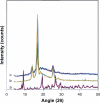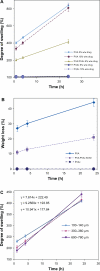Composite poly(vinyl alcohol)/poly(vinyl acetate) electrospun nanofibrous mats as a novel wound dressing matrix for controlled release of drugs
- PMID: 21720511
- PMCID: PMC3124403
- DOI: 10.2147/IJN.S17595
Composite poly(vinyl alcohol)/poly(vinyl acetate) electrospun nanofibrous mats as a novel wound dressing matrix for controlled release of drugs
Abstract
The aim of this study was to develop novel biomedicated nanofiber electrospun mats for controlled drug release, especially drug release directly to an injury site to accelerate wound healing. Nanofibers of poly(vinyl alcohol) (PVA), poly(vinyl acetate) (PVAc), and a 50:50 composite blend, loaded with ciprofloxacin HCl (CipHCl), were successfully prepared by an electrospinning technique for the first time. The morphology and average diameter of the electrospun nanofibers were investigated by scanning electron microscopy. X-ray diffraction studies indicated an amorphous distribution of the drug inside the nanofiber blend. Introducing the drug into polymeric solutions significantly decreased solution viscosities as well as nanofiber diameter. In vitro drug release evaluations showed that both the kind of polymer and the amount of drug loaded greatly affected the degree of swelling, weight loss, and initial burst and rate of drug release. Blending PVA and PVAc exhibited a useful and convenient method for electrospinning in order to control the rate and period of drug release in wound healing applications. Also, the thickness of the blend nanofiber mats strongly influenced the initial release and rate of drug release.
Keywords: biodegradable polymers; controlled release; drug delivery; electrospun nanofibers; wound dressing.
Figures









References
-
- Pal K, Banthia AK, Majumdar DK. Polyvinyl alcohol-glycine composite membranes: preparation, characterization, drug release and cytocompatibility studies. Biomed Mater. 2006;1:49–55. - PubMed
-
- Yu H, Xu H, Chen X, Hao J, Jing X. Medicated wound dressing on poly (vinyl alcohol)/poly(N-vinyl pyrrolidone)/chitosan hydrogels. J Appl Polym Sci. 2006;101:2453–2463.
-
- Tsou TL, Tang ST, Huang YC, Wu JR, Young JJ, Wang HJ. Poly (2-hydroxyethyl methacrylate) wound dressing containing ciprofloxacin and its drug release studies. J Mater Sci Mater Med. 2005;16:95–100. - PubMed
-
- Suzuki K, Tanihara M, Nishimura Y, Suzuki K, Kakimaru Y, Shimizu Y. A new drug delivery system with controlled release of antibiotic only in the presence of infection. J Biomed Mater Res. 1998;42:112–116. - PubMed
-
- Boateng JS, Matthews K, Stevens HNE, Eccleston GM. Wound healing dressings and drug delivery systems: a review. J Pharm Sci. 2008;97:2892–2923. - PubMed
Publication types
MeSH terms
Substances
LinkOut - more resources
Full Text Sources
Other Literature Sources
Miscellaneous

